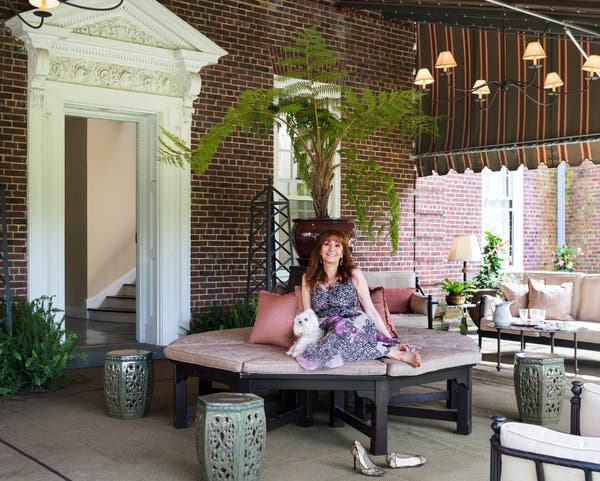As the sun broke through clouds, spotlighting the formal gardens and splashing fountains at her 10,000-square-foot Georgian Revival house in Oyster Bay Cove, N.Y., Constance Cincotta recalled how she had never planned to leave her city life.
“I was living in Brooklyn, and had no interest in Long Island,” said Ms. Cincotta, 58, the owner of Glenwood Mason Supply Company in Brooklyn.
But in 2002, a friend sent her a real estate magazine featuring homes for sale in Nassau County, and when she saw the 1931 residence on the cover, she was awe-struck. “It was the house of my dreams, literally,” she said. “A Georgian house had been my ideal home forever. I’m a huge Anglophile. It was just everything I wanted.”

CreditAdam Macchia for The New York Times
It also happened to be constructed from handsome red brick, which seemed fitting for a woman who spends her days selling masonry products and manufacturing concrete block. Growing up, she said, “We had a wooden Victorian in Brooklyn, and my father would always say, ‘Oh, God, I’m in the brick business and I have a wood house. This is terrible.’”
The Oyster Bay Cove estate, known as Highwood, was designed by the architect Henry Corse and the landscape architecture firm Innocenti & Webel for Edwin Gould, a son of the railroad financier Jay Gould. It had changed hands over the years, and its extensive property had been subdivided, but the stately old house remained largely as it ever was, with its big divided-light windows, paneled library and terrazzo floors intact, and its gardens overgrown.
When she went to see the four-acre property, Ms. Cincotta walked through the house twice and then made an offer on the spot, for about $3.5 million.
She sold her house in Brooklyn and her second home in the Breezy Point neighborhood of Queens, packed her belongings and made the move to this small village about 25 miles northeast of the city. Her father joined her and lived there until he died in 2007; they used a pair of walkie-talkies to communicate from distant parts of the expansive residence.
At first, the house and landscape didn’t seem to need much work. Ms. Cincotta renovated the bathrooms, which had last been updated in the 1970s, but otherwise relished the idea of using the partially empty house as a venue for entertaining.
On occasion, she had blockbuster family reunions with more than 50 overnight guests. “We had the living room set up dormitory style, with all these air mattresses,” she said.
But by 2006, she realized she needed help to create a cohesive, finished look. “When I brought my furniture in, it seemed like dollhouse furniture because of the scale of the rooms,” she said. “I was really intimidated about decorating.”
While shopping at the store and studio run by Andrew Maier, an interior designer in nearby Locust Valley, she decided she had found someone who could help. “I clicked with Andy immediately,” she said.
First she asked him to furnish the pool house, which he outfitted with an Oushak rug, an oversized antique wall clock, and a sofa and chairs from Crate & Barrel with washable slipcovers that could withstand abuse from Ms. Cincotta’s dogs, Dixie and Mason.
“It’s all very dressy,” Mr. Maier said. “Connie wasn’t doing sisal and typical pool-house stuff.”
Ms. Cincotta loved it. “So I asked him to do my living room,” she said.
There, Mr. Maier cleaned up and painted the original dentil molding, the marble-and-wood fireplace mantel and a faux door designed to give the room a sense of symmetry. He also added corner settees, an oversized velvet sofa and occasional tables — antique wood bases with column-like details for which he designed black-and-gold marble tops.
Gradually, during the years that followed, Ms. Cincotta tasked Mr. Maier with redesigning and decorating various parts of the house, including the library, the dining room, the master suite, a casual dining area off the kitchen and the terrace, as well as several outbuildings.
She also had Mr. Maier convert what was once a ladies’ sitting room into a standing bar, while maintaining the original verre églomisé wall mirrors. The new design, she said, reflects the active lives of women today: “We don’t sit.”
To restore and maintain the gardens, she hired Mary MacDonald, a landscape designer in Locust Valley.
“Without having the original drawings, we tried to put it back to what it was,” said Ms. MacDonald, who replaced, replanted and pruned what was there, all the while “keeping in mind today’s maintenance requirements,” she said, for an estate without full-time gardeners.
Along the way, Ms. Cincotta also had brick walls restored and the home’s clay-tile roof repaired when it began to fail.
Now she frequently uses the property to hold fund-raisers for local causes and groups, including Preservation Long Island, the North Shore Historical Museum and the Interfaith Nutrition Network.
Ms. Cincotta estimated that updating and maintaining the house has cost about as much as she paid to buy it. But bringing Highwood back to its former glory has been a profound experience that goes beyond a simple investment, she said: “It completely changed my life.”
For weekly email updates on residential real estate news, sign up here. Follow us on Twitter: @nytrealestate.







